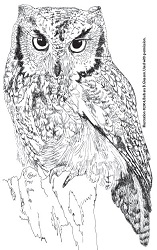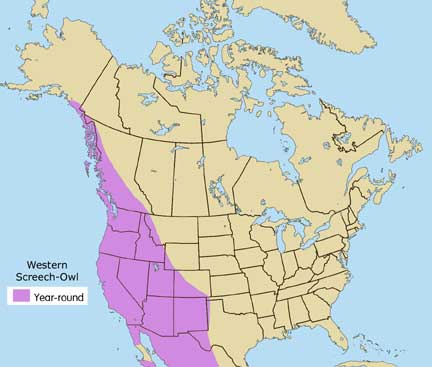
Scientific Name: Megascops kennicottii
This owl has small, wide-set feather tufts that often lead finders to think this is a “baby great horned owl”; large, yellow eyes; streaked underparts (w/ horizontal black barring in the juveniles changing to irregular vertical streaks in adult plumage); very well camouflaged for its day-time roosts against the trunks of trees; biggest of the little owls.
Male/Female
Length: 9+”
Wingspan: 18-24″
Weight: 4-8 oz.
State and federally protected.
Woodlands, orchards, and backyard groves; locally, can be found throughout the urban area wherever trees provide sufficient cover; studies have shown this species to actually live longer and have better nesting success in suburban areas than in rural areas, probably due to plenty of food such as moths and beetles attracted to house lights or gardens, mice, and perhaps fewer predators, such as the larger owls who might not be as willing to live so close to humans.
Small mammals, birds, reptiles and large insects.
Has a wide variety of vocalizations, none at all like a ‘screech,’ though the Eastern Screech Owl is reputed to screech. Most common call is a quivering whistle that ends in a downward cascade, often likened to a ping-pong ball’s bounce: hoo-hoo-hoo-hoo-oo-oo.
Roosts and lays eggs in cavities; young go through stage of ‘branching’ before fully capable of flight in which they leave the nest to explore, but are still being cared for by adults.
As with all owls, the most common cause of injury is collision with cars/trucks; other problems – flying into windows, falling down chimneys in search of nesting site, poisoning (through insecticides and rodenticides), tangling in fishing line. Young owls are most frequently brought in by well-intentioned people who find them on the ground or in plain sight during the ‘brancher’ stage but see no sign of parents; nest trees are cut down with young or eggs; young get knocked out of trees by crows or caught by cats.

Most of the western United States.
Special Thanks for range maps:
Dan Gleason
BGleason Design & Illustration
Commercial & Scientific Illustration, Graphic Design
CraneDance Communications
Book Production/Design

